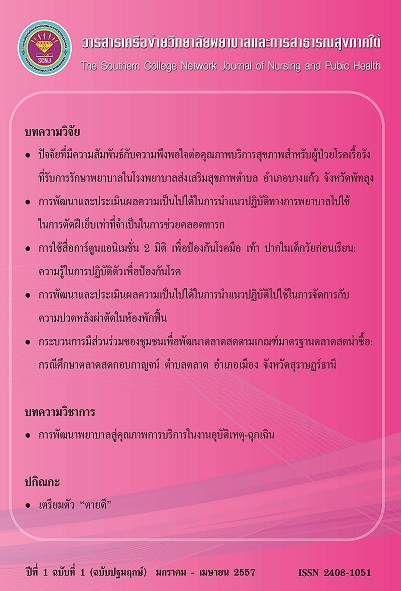การพัฒนาพยาบาลสู่คุณภาพการบริการในงานอุบัติเหตุ-ฉุกเฉิน
คำสำคัญ:
คุณภาพของพยาบาล, คุณภาพงานอุบัติเหตุ-ฉุกเฉิน, สมรรถนะของพยาบาลวิชาชีพ, Continued Training of Nurses, Emergency Roomบทคัดย่อ
ห้องอุบัติเหตุ-ฉุกเฉินเป็นหน่วยงานสำคัญและมีความเสี่ยงสูง บุคลากรของห้องอุบัติเหตุ-ฉุกเฉินจึงต้องมีความพร้อมในการดูแลรักษาผู้ป่วยอยู่ตลอดเวลา โดยมีเป้าหมายมุ่งเน้นที่คุณภาพการพยาบาลคือ ผู้ป่วยต้องได้รับการดูแลอย่างถูกต้อง รวดเร็ว ปลอดภัยและสามารถกลับไปดูแลตนเองได้ ผู้บริหารการพยาบาลจึงต้องพัฒนาระบบการจัดอัตรากำลัง และสมรรถนะของพยาบาลวิชาชีพให้มีความพร้อมทั้งด้านปริมาณและคุณภาพ คือ 1) การจัดอัตรากำลังพยาบาลวิชาชีพ และ 2) สมรรถนะของพยาบาลวิชาชีพ โดยใช้วิธีการพัฒนาสมรรถนะที่สอดคล้องกับบริบทของโรงพยาบาลชุมชน ได้แก่ 1) ฝึกปฏิบัติจากการทำงานควบคู่กับระบบพี่สอนน้อง 2) จัดทำแบบบันทึกเฉพาะโรคที่ชี้นำการปฏิบัติ 3) แลกเปลี่ยนเรียนรู้ร่วมกันในวิชาชีพเดียวกันและสหสาขาวิชาชีพ และให้ความสำคัญกับการจัดสิ่งแวดล้อมให้เอื้อต่อการเรียนรู้และการสร้างบรรยากาศการทำงานอย่างมีความสุข
The Importance of a Continued Training Program in order to Maintain and Improve the Competencies of the Emergency Room Nurses
The Emergency Room (ER) is a crucial unit that provides care for patients who are in the need for emergency health intervention or in a critical phase of their illness. Nurses who work in this department need to be well prepared; it is to say ready to execute protocol or treatment for patients at any time. The goal is to focus on the quality of nursing care. The nurses must be skilled and rapid at performing accurate physical examination, early recognition of life-threatening illness or injury, as well as the use of advanced monitoring while managing the latest treatment equipment. Human resources administrators must develop a continued training program in order to maintain and improve the competencies of the nurses. That program has to be consistent with the concept of community hospital, which includes in particular the following three aspects: 1) On-thejob training methods along with the coaching system, 2) The preparation of a record of specific disease to guiding practice, 3) The knowledge sharing among multidisciplinary and the building of supportive environment in learning and working.ดาวน์โหลด
เผยแพร่แล้ว
ฉบับ
ประเภทบทความ
สัญญาอนุญาต
1. บทความหรือข้อคิดเห็นใด ๆ ที่ปรากฏในวารสารเครือข่าย วิทยาลัยพยาบาลและการสาธารณสุขภาคใต้ ที่เป็นวรรณกรรมของผู้เขียน บรรณาธิการหรือเครือข่ายวิทยาลัยพยาบาลและวิทยาลัยการสาธารณสุขภาคใต้ ไม่จำเป็นต้องเห็นด้วย
2. บทความที่ได้รับการตีพิมพ์ถือเป็นลิขสิทธิ์ของ วารสารเครือข่ายวิทยาลัยพยาบาลและการสาธารณสุขภาคใต้








